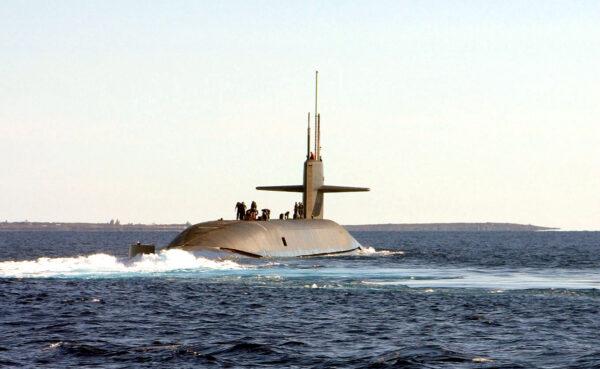The Pentagon’s budget proposal for fiscal year 2021 keeps the U.S. military on course to counter China and Russia, boosting hypersonic missiles, nuclear modernization, 5G technologies, and missile defense, as well as the newly minted Space Force.
After three years of ramped-up military spending, the proposal is virtually flat at $740 billion—just $2 billion more than the current year. The Department of Defense request is technically $705 billion, but another $35 billion is earmarked for a sister agency that handles nuclear weapons.
The White House announced its 2021 FY budget proposal of $4.8 trillion on Feb. 10.
The 2021 budget request must now run the gauntlet of Congress, which has ratcheted up annual military spending by over $100 billion since 2017 but had already set a cap on the 2021 proposal.
The latest proposal supports the “irreversible implementation” of the 2018 National Defense Strategy—the Trump administration’s military game plan, the Pentagon says. That plan points to countering China and Russia’s rising military prowess as the top priority, pivoting away from the rolling demands of counter-insurgency toward modernizing for the next-generation warfighting environment.
According to the Pentagon, the budget proposal also advances critical technologies “including hypersonics, microelectronics/5G, and artificial intelligence.”
Hypersonics are the latest military super-power brag, already touted by Russia and China—a new type of missile that is able to maneuver at high speed and potentially dodge anti-missile defenses.
A latecomer to the hypersonic race, the United States is rushing to overtake its rivals. The budget proposal puts aside $3.2 billion to invest in hypersonics—a 23 percent increase on the previous year.
The Space Force, which was established late last year, gets a 28 percent increase in the budget request.

The Smallest Military Since 1940
At $106.6 billion, the research, development, test, and evaluation request is the largest in 70 years, according to the Pentagon.The Trump administration inherited a military that had been operating under “destructive spending caps,” Deputy Secretary of Defense David Norquist told reporters at the budget proposal briefing. That left the United States with its smallest military since 1940, along with key munition shortages, low readiness levels, and an outdated nuclear deterrent, he said.
“At the same time, we are grappling with a new warfighting environment, given the reemergence of great power competition from Russia and China,” he said. “One thing had become evident—wars of the future were going to be radically different than the short conventional wars and protracted counterterrorism operations we have fought since the collapse of the Soviet Union.”
Because of bipartisan support, he said in the past three years, the Pentagon received the increased funding needed to rebuild and modernize the military.
The spending ramp-up stopped last year, with Congress having already locked in the FY 2021 flatline budget in their 2019 defense authorization act.
But the Pentagon’s thirst for modernization is unquenched.
“That means that we had to make additional tough choices and major cuts in some areas in order to free up money to continue to invest in preparing for the high-end fight,” Norquist said.
Trapped Between the New and Old
The military’s pivot away from a counter-insurgency outfit is hampered by Cold War legacy systems and old maintenance-heavy equipment. That’s especially so for the Air Force and the Navy, with their slow-build, big-ticket items that can get battered in the political winds.The military is trapped between the high costs of maintaining out-of-date equipment and the high costs of buying new gear.
For example, at 28 years old, the average age of Air Force fighter planes is higher than at any point in the history of the service. The average age of bombers is around 45 years.
Older equipment isn’t just behind the tech curve—it’s also more expensive to maintain.
The Pentagon’s FY 2021 budget request would retire a portion of its B-1 bombers, A-10 Warthog attack planes, RQ-4 Global Hawk surveillance drones, KC-135 and KC-10 tankers, and C-130H planes.
According to the White House, the budget supports the Department of Defense’s effort to divest $20 billion of legacy systems.
Adding to the difficulty of budget choices is the changing military challenge. China and Russia have built up their militaries specifically to counter the dominance of major U.S. military investments that once assured dominance.
The Navy and Air Force cutbacks and changes don’t go as far as making the difficult choices some strategists suggest will be needed, and effectively kick the can down to the political crossroads of the November election.
The Navy budget doesn’t yet reach the goal of a 355-ship fleet, which the Pentagon is committed to working toward by law.

The Navy budget proposes cutting its shipbuilding budget by $4 billion.
According to the Army, its budget request continues to bolster its six modernization priorities: long-range missiles, next-generation lift (helicopters), soldier lethality, next-generation combat vehicles, missile defense, and improved network.
The Marine Corps, which is reinventing itself as an expeditionary force to counter China in the Pacific, would lose over 2,000 active-duty Marines. Meanwhile, the Navy would grow in numbers by about 5,300.





